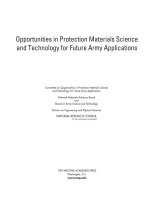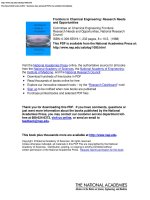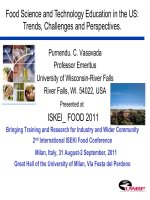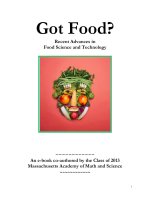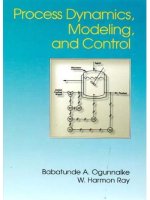new topics in food engineering (food science and technology)
Bạn đang xem bản rút gọn của tài liệu. Xem và tải ngay bản đầy đủ của tài liệu tại đây (7.17 MB, 326 trang )
FOOD SCIENCE AND TECHNOLOGY
NEW TOPICS IN FOOD ENGINEERING
No part of this digital document may be reproduced, stored in a retrieval system or transmitted in any form or
by any means. The publisher has taken reasonable care in the preparation of this digital document, but makes no
expressed or implied warranty of any kind and assumes no responsibility for any errors or omissions. No
liability is assumed for incidental or consequential damages in connection with or arising out of information
contained herein. This digital document is sold with the clear understanding that the publisher is not engaged in
rendering legal, medical or any other professional services.
FOOD SCIENCE AND TECHNOLOGY
Additional books in this series can be found on Nova’s website
under the Series tab.
Additional E-books in this series can be found on Nova’s website
under the E-books tab.
FOOD SCIENCE AND TECHNOLOGY
NEW TOPICS IN FOOD ENGINEERING
MARIANN A. COMEAU
EDITOR
Nova Science Publishers, Inc.
New York
Copyright © 2011 by Nova Science Publishers, Inc.
All rights reserved. No part of this book may be reproduced, stored in a retrieval system or
transmitted in any form or by any means: electronic, electrostatic, magnetic, tape, mechanical
photocopying, recording or otherwise without the written permission of the Publisher.
For permission to use material from this book please contact us:
Telephone 631-231-7269; Fax 631-231-8175
Web Site:
NOTICE TO THE READER
The Publisher has taken reasonable care in the preparation of this book, but makes no expressed or
implied warranty of any kind and assumes no responsibility for any errors or omissions. No
liability is assumed for incidental or consequential damages in connection with or arising out of
information contained in this book. The Publisher shall not be liable for any special,
consequential, or exemplary damages resulting, in whole or in part, from the readers’ use of, or
reliance upon, this material. Any parts of this book based on government reports are so indicated
and copyright is claimed for those parts to the extent applicable to compilations of such works.
Independent verification should be sought for any data, advice or recommendations contained in
this book. In addition, no responsibility is assumed by the publisher for any injury and/or damage
to persons or property arising from any methods, products, instructions, ideas or otherwise
contained in this publication.
This publication is designed to provide accurate and authoritative information with regard to the
subject matter covered herein. It is sold with the clear understanding that the Publisher is not
engaged in rendering legal or any other professional services. If legal or any other expert
assistance is required, the services of a competent person should be sought. FROM A
DECLARATION OF PARTICIPANTS JOINTLY ADOPTED BY A COMMITTEE OF THE
AMERICAN BAR ASSOCIATION AND A COMMITTEE OF PUBLISHERS.
Additional color graphics may be available in the e-book version of this book.
L
IBRARY OF CONGRESS CATALOGING-IN-PUBLICATION DATA
New topics in food engineering / editor: Mariann A. Comeau.
p. cm. (Food science and technology)
Includes index.
ISBN
978-1-61209-896-8 (eBook)
1. Food industry and trade. I. Comeau, Mariann A. II. Series: Food science and technology
series (Nova Science Publishers)
TP370.N44 2011
664 dc22
2011002382
Published by Nova Science Publishers, Inc.
©
New York
CONTENTS
Preface vii
Chapter 1 Tempering, Polymorphism and Fat Crystallization During Industrial
Chocolate Manufacture: Regimes, Behaviours and their Effects on
Finished Chocolate Quality 13
Emmanuel Ohene Afoakwa and Alistair Paterson
Chapter 2 Non-linear Modeling of Quality of Cooked Ground Beef Patties
with Visible-NIR Spectroscopy 35
Sreekala G. Bajwa and Jason K. Apple
Chapter 3 Molecular Size Distribution in Long-aged Food Beverages and
Alcoholic Drinks: A Preliminary Inquiry towards Understanding
Physical-and Sensory-Related Properties 57
Pasquale Massimiliano Falcone and Paolo Giudici
Chapter 4 Hyperspectral Waveband Selection for Detection of Almonds
with Internal Damage 81
Songyot Nakariyakul
Chapter 5 High Frequency Ultrasonic Techniques Dedicated to Food
Physical Properties Assessment 99
D. Laux, J. Y. Ferrandis, V. Cereser Camara, H. Blasco
and M. Valente
Chapter 6 Trends in High Pressure Processing of Foods: Food Quality
and Bioactive Components 121
Shirani Gamlath and Lara Wakeling
Chapter 7 Thermodynamic and Kinetic Criteria to Study the
Stability of Dried Foods 151
Cesar I. Beristain, Eduardo J. Vernon-Carter
and Ebner Azuara
Chapter 8 Development of Vacuum Spray Drying System for Probiotics
Powder 171
Yutaka Kitamura and Yukari Yanase
Contents vi
Chapter 9 Application of Vacuum Impregnation and Edible Films to Improve
The Quality of Raisin-Cereal Systems 233
Pau Talens and María José Fabra
Chapter 10 Food Packaging: Innovative Concept and Necessities 249
Kelen Cristina Dos Reis
Chapter 11 Predictive Modelling of Thermal Properties of Foods 261
James K. Carson
Chapter 12 Applications of Membrane Contactors in the Food Industry 279
Catherine Charcosset
Chapter 13 Possibilities for Removal of Glucose From Various
Foodstuffs and Food Bioprocesses 289
K. Bélafi-Bakó
Chapter 14 Instant Rice Physicochemical Properties and Eating Quality 301
Prisana Suwannaporn
Index 313
PREFACE
In the development of food engineering, one of the many challenges is to employ modern
tools and knowledge to develop new products and processes. Simultaneously, improving
quality, safety, and security remain critical issues in food engineering. Additionally, process
control and automation regularly appear among the top priorities identified in food
engineering. This book presents topical research in the study of food engineering, including:
ozone technology in the food industry; current trends in drying and dehydration of foods;
strategies for extending the shelf-life of foods using antimicrobial edible films; developments
in high-pressure food processing; as well as tempering and polymorphism during chocolate
manufacture.
Chapter 1 - Tempering, a technique of shearing chocolate mass at controlled temperatures
is used to promote cocoa butter crystallization in a thermodynamically stable polymorphic
form. During chocolate manufacture, the process is used to obtain the stable form V (or ß
2
) of
cocoa butter having a melting temperature of 32-34 °C, which gives the desired glossy
appearance, good snap, contraction and enhanced shelf life characteristics. However, the
tempering sequences, their behaviour during pre-crystallization, the consequential regimes
attained and their effects on product quality characteristics are not very well understood.
Variations in temper regimes attained during pre-crystallization of chocolates influence their
crystallinity, polymorphic status and other physical quality characteristics. Over-tempering
causes increases in product hardness, stickiness with reduced gloss and darkening of product
surfaces. Under-tempering induces fat bloom in products with consequential quality defects in
structure, texture, melting properties and appearance (colour and surface gloss). Thus, the
different temper regimes attained during pre-crystallization result in wide variations in
product quality attributes with varied influences on quality. In a modern competitive
confectionery market, understanding the variables leading to chocolate pre-crystallization
during tempering and effects of the regimes attained on the quality of the finished products
are vital to assurances in quality and shelf characteristics.
Chapter 2 - Chemometric models based on partial least square regression (PLSR) have
been successfully used to estimate nutrient content of different raw meat products from
spectroscopic measurements. Preliminary studies to establish a chemometric model for
estimating nutrient concentration of cooked ground beef patties from spectroscopic data
indicated that the linear PLSR models are not adequate to represent fat and calories.
Therefore, this study was conducted to examine two non-linear modeling methods using
PLSR and artificial neural networks (ANN). In this study, spectral absorbance in the visible
and near infrared (VNIR) region along with data from proximate analysis was utilized to
Mariann A. Comeau viii
develop and validate the two non-linear models for predicting fat, calories, cholesterol and
moisture content of cooked ground beef patties. When compared to a linear chemometric
model based on PLSR, both non-linear models performed significantly better. The ANN
model exhibited the best performance which was indicated by a validation R
2
value of 0.93
and residual predictive deviation (RPD) of 3.3 and 3.4 for fat and calories respectively. Both
non-linear models resulted in RPD ≥ 3 under validation, indicating that they are acceptable.
However, the model performance was only fair for cholesterol and moisture content.
Chapter 3 - The present study supports the idea that physical- and sensory-related
properties of long-aged beverages and alcoholic drinks containing reducing sugars would be
described not by an unique value rather as a distribution of values due to the time-dependent
increase of molecular heterogeneity in molecular sizes and structure. A wide range of
beverages and alcoholic drinks obtained after different aging periods at room temperature
were fractioned by Size-Exclusion Chromatography (SEC), then the elution profiles were
analyzed by using a chemical-groups sensitive detector, i.e. an ultraviolet-visible (UV-VIS),
coupled to a mass-sensitive detector. i.e. a differential refractive device (DRI). The analysis
of the probability density function as well as of the cumulative density function allowed
comparing the distribution properties over a wide range among the investigated samples. This
is because, unlike small molecules, such liquid matrices undergo accumulation of high
molecular size biopolymers (melanoidins) throughout the aging period. In general, results
proved that all the investigated matrices would be defined as heterogeneous mixtures of
chromophore-labeled
copolymers, uncolored and brown, highly polydispersed with respect to
their molecular size (ranging between 0.2kDa to over 2000kDa) and their chemical structure.
In particular, the molecular size distribution of the end-products was attributed to the raw
materials used for their production; while, the relative content of the biopolymers is strictly
related to the extent of the thermal treatment applied along to the making process (when it is
applied) as well as to the length of the storage time at room temperature.
Chapter 4 - Detection of concealed damage in almonds is an important production
inspection application. Internally damaged almonds are not easily distinguished from normal
ones by their external appearances, and, when cooked, they taste bitter. Prior study showed
that using the whole spectrum of hyperspectral data from 700-1400 nm could distinguish
internally damaged nuts from normal ones at an error rates as low as 12.4%. However, the
hyperspectral system is rather slow and cannot achieve an inspection rate of 40 nuts/s
required by almond processing plants. Thus, a feature selection algorithm is needed to choose
only a small subset of useful wavebands from hyperspectral data for use in a real-time
multispectral camera. In this study, author introduce two novel feature selection techniques;
one method is developed to select an optimal subset of individual wavebands, while the other
aims to find good sets of band ratios. Author thoroughly discuss the advantages and
disadvantages of both algorithms. Experimental results demonstrate that the author proposed
methods give higher classification rates than other state-of-the-art algorithms.
Chapter 5 - Usually, viscoleastic properties of materials (complex shear moduli and
viscosity) are evaluated with rheometers which can give G’, G’’ for instance, on wide
bandwidths thanks to the Time Temperature Superposition principle. It is clear that the
knowledge of such properties is very interesting on a fundamental point of view because
information on material microstructure can be deduced from master curves. On a more
practical point of view, it can be used to improve fabrication processes, to perform quality
controls, especially in food industry and engineering. This powerful method can fail to give
Preface ix
large bandwidth information in several cases: phase transition of the material with
temperature, volume to be analyzed too small, bad morphology of the sample. In order to
overcome such a difficulty, it is possible to use ultrasonic waves. This paper, dedicated to
high frequency methods (from a few kHz to many MHz) presents a review of existing
methods and improvements developed in the author labs. Several applications in the domain
of food engineering will be given in order to prove the huge interest of high frequency
approaches which are sometimes neglected compared to classical low frequency rheology.
Chapter 6 - High pressure processing (HPP) is a non-thermal food processing technology
that offers great potential for the processing of a wide range of food products. Application of
HPP can inactivate micro-organisms, affect food-related enzymes and modify structures with
minimal changes to nutritional and sensory quality aspects of foods. The effects of high
pressure on the inactivation of micro-organisms in food have been thoroughly reviewed.
Recent research on HPP has mainly focused on fruits and vegetables with an emphasis on
food quality and bioactive components. This chapter highlights the current trends in HPP
research and provides a summary of the available findings on the effect of HPP on chemical,
nutritional and bioactive components and health related properties of a wider range of
commodities. Strategies to maintain the quality attributes and health related components in
HPP foods and identification of the gaps for future research in HPP are also discussed.
Chapter 7 - In order to assure the quality of dry foods it is important to maintain a strict
control over the moisture content and temperature conditions during storage. Quality loss in
dry foods can be due to enzymatic and non-enzymatic browning, lipid oxidation, loss of
nutrients, loss of flow and microbial contamination, among other factors properties.
Determining the optimum moisture content and temperature conditions that minimize the
detrimental processes of foods is a difficult task that requires a profound understanding of the
interactions of water with other food ingredients. Despite the use of increasingly sophisticated
analytical techniques that seek to shed information regarding water-food interactions and
water-water interactions, the water sorption mechanism in foods is not still understood
wholly. The majority of foods can be considered as complex colloidal systems in which
amorphous and crystalline regions occur, with water acting as a plasticizer. Water is a solvent
that may take part in detrimental reactions, but in most cases, acts as a medium that provides
mobility to reactants allowing them to come into close contact and react. Thus, it is
convenient to control the participation of water within foods. Up to date there is still not a
100% reliable method for predicting and controlling food stability. Both, the water activity
and the glass transition, are parameters that have been accepted as of food stability criteria
worldwide. However, several scientific studies have demonstrated that both parameters
exhibit great limitations, and that it is necessary to approach this problem from a fresh point
of view. Regarding this, two factors are worthwhile considering: (1) equilibrium or
thermodynamic considerations, and (2) rate or kinetic processes. A reaction may not take
place if the thermodynamic parameters are unfavorable. Thus, management of the
thermodynamic parameters that describe the state of a food is a good starting point for
achieving a better understanding of the stability of stored food. On the other hand, even when
a reaction is thermodynamically feasible, it cannot occur if the process kinetics does not occur
at a feasible rate. In this chapter the thermodynamic and rate processes are proposed as
criteria for establishing the stability of stored dry foods. It will also be shown that these two
factors are closely interrelated, as the equilibrium state of a system depends in great measure
Mariann A. Comeau x
of the kinetics followed to reach it. Furthermore, it will be established that it is possible to
improve food stability by controlling its microstructure.
Chapter 8 - In recent years, health consciousness has grown in relation to health hazards
associated with lifestyle and living environment, and various types of functional foods are
attracting attention (Matsuda, 2002; Bureau of Citizens, Culture and Sports, Tokyo
Metropolitan Government, 2005; Sashihara et al., 2005). In addition, the functionality of food
is currently an important added value for the food industry, and the development and
applications of functional foods are being actively advanced. Among various functional
foods, probiotics is one of the materials that have attracted considerable attention (Sashihara
et al., 2005). Probiotics are living microbes that exert healthful effects on the living body,
lactic acid bacteria being a typical example. The wide-ranging health effects of various types
of bacteria have been reported, as shown in Table 1.1. Further, epidemiological studies on
probiotics for disease prevention and scientific study and commercial development involving
useful lactic acid bacteria are being pursued (Watanabe et al., 2005). Probiotic foods are able
to ameliorate the effects of environmental factors, and are useful in disease prevention;
establishing the safety of probiotics is easy as compared to doing so for medical chemicals,
because the bacterial cells of probiotics have long been used for storing and improving the
flavor of food. Therefore, various probiotic foods are being researched, developed, and
produced. These will be indispensable functional ingredients in the future food industry in
Japan, where health consciousness is increasing.
Chapter 9 - The shelf life of multicomponent food systems depends, among others things,
on how fast the water transfer between components takes place. This moisture migration can
result in undesirable physical and chemical changes in the system, affecting its quality and
shelf life. Several factors influence the amount and rate of moisture migration in
multicomponent foods. However, water activity equilibrium and rate of diffusion are the two
main factors. To control this migration, several principles can be utilized. A raisin-cereal
mixture is one of the multicomponent food systems whose quality and shelf life is affected by
moisture migration between components. In this system, water is transported from the raisin
to the cereals, resulting in quality deterioration to both components. One way to reduce the
moisture migration in this system is to reduce the water activity of raisins. The problem is that
the raisin texture, one of most important factors governing their quality, becomes
unacceptably hard when their water activity decreases below 0.40. Another possibility for
controlling moisture migration is to add an edible barrier between components.
In this study, in order to try to reduce the water activity of raisins, while maintaining their
softness, raisins were infused with a glycerol-water solution (5:1) applied by vacuum
impregnation. Mechanical properties, weight changes and water activity were evaluated
before and after infusion to study the effect of the glycerol on raisins. On the other hand, in
order to try to reduce the moisture transfer between components, the raisins were coated by
directly applying starch and beeswax to them or by using different film forming emulsions
made with whey protein, beeswax and glycerol at different protein:lipid:plasticizer ratios.
The results of these application procedures have shown that the use of combined solute
infusion and vacuum impregnation methods are an effective way of reducing the water
activity properties of the raisins as well as serving as an alternative formula towards
maintaining raisins at their best possible conditions for keeping a homogenous raisin-cereal
system. After 1 hour of treatment with glycerol, testing revealed that the water activity of the
raisins decreased, thus decreasing the gradient of water activity between both components.
Preface xi
Furthermore, testing has indicated that this treatment does not affect the texture of raisins.
The hardness of the raisin skin was not influenced by the presence of glycerol, allowing for a
produced softness inside the raisins. As regards to the testing of various coating effects, the
direct application of beeswax seemed to be the best protection from water loss. Among the
film forming emulsions based on whey protein, the higher plasticizer content lead to a
decrease in the water loss protection; although, these differences were not significant. In spite
of the fact that the tested films have different water vapour permeabilities when they are
treated as independent structures, it seems that the interactions that transpired, between these
films and the surface of the product, eliminated the above mentioned differences.
Chapter 10 - The type of packaging used has an important role in determining the shelf
life of a food and the main purpose of food packaging is to protect the food from microbial
and chemical contamination, oxygen, water vapour and light. Innovative food packaging
concepts has been introduced as a response to the continuous changes in current consumer
demands and market trends.
Chapter 11 - Thermal properties of foods are vital inputs for many food process models.
With the recent advances in mathematical modelling and significant reduction in the cost of
computational power, uncertainties in model inputs are more and more becoming the limiting
factor in model accuracy rather than the model formulation or solution process. In this chapter
methods and models are presented for predicting thermal properties based solely on data for
the composition of the food in terms of its basic components (liquid water, ice, protein, fat,
carbohydrate, ash and air). This type of model provides genuine predictions of thermal
properties since no thermal property measurements are required, as is necessary with some
effective property models that may be found in the literature. Foods are divided into different
classes, depending on the difficulties they pose for thermal properties prediction. Simple
guidelines for thermal property prediction are presented along with worked examples to serve
as illustrations.
Chapter 12 - Membrane contactors represent an emerging technology in which the
membrane is used as a tool for inter phase mass transfer operations [Sirkar et al. 1999, Drioli
et al. 2003]. The membrane does not act as a selective barrier, but the separation is based on
the phase equilibrium. This review specifically addresses to two membrane contactor
processes: membrane distillation and membrane emulsification and their applications in the
food industry.
Chapter 13 - In many areas of food industry removal of glucose is considered as an
important step in the processing line. In some raw materials – like eggs – glucose
concentration should be reduced to avoid undesired co-reaction during drying process. In the
beverage industry glucose level of certain fruit juices needs to be controlled/lowered either to
produce low-caloric beverages or to get low-alcohol wine after fermentation (e.g. grape
must). In addition glucose removal is a significant step in some enzymatic processes like
polysaccharide hydrolysis or fructo-oligosaccharide synthesis, where glucose is an inhibitory
by-product. Separation methods applicable for glucose removal are discussed and compared
in this chapter.
Chapter 14 - Instant, or quick-cooking, rice is becoming more popular nowadays.
However, it still poses problems with respect to rehydration time and quality. The effects of
processing factors which are: moisture content, pressure and drying temperature has a
significant effect on its physicochemical properties and eating quality. The hardness and
chewiness of rice decreased as moisture content and pressure increased. Higher drying
Mariann A. Comeau xii
temperatures caused increases in hardness and chewiness. Only pressure and moisture content
affected density, rehydration ratio, and increase in the volume of instant rice, which was due to
the porosity of the kernels. Rehydration ratio had a negative correlation with density (r= -
0.886) but a positive correlation with volume increase (r = 0.637). Pressure was the main
factor influencing the pasting properties of instant rice. All pasting properties of instant rice
were far lower than those of milled rice, but instant rice had higher cold paste viscosity, which
is typical of pregelatinized flour. This indicated rapid water absorption and shorter cooking
time. Instant rice processing also caused development of amylose-lipid complexes observed
as the V-type pattern in an X-ray diffractometer
In: New Topics in Food Engineering ISBN: 978-1-61209-599-8
Editor: Mariann A. Comeau © 2011 Nova Science Publishers, Inc.
Chapter 1
TEMPERING, POLYMORPHISM AND FAT
CRYSTALLIZATION DURING INDUSTRIAL
CHOCOLATE MANUFACTURE: REGIMES,
BEHAVIOURS AND THEIR EFFECTS ON FINISHED
CHOCOLATE QUALITY
Emmanuel Ohene Afoakwa
1
*
and Alistair Paterson
2
1
Department of Nutrition and Food Science, University of Ghana
P. O. Box LG 134, Legon – Accra, Ghana
2
Centre for Food Quality,
Strathclyde Institute of Pharmacy and Biomedical Sciences,
University of Strathclyde, Royal College Building,
204 George Street, Glasgow G1 1XW, U. K.
ABSTRACT
Tempering, a technique of shearing chocolate mass at controlled temperatures is
used to promote cocoa butter crystallization in a thermodynamically stable polymorphic
form. During chocolate manufacture, the process is used to obtain the stable form V (or
ß
2
) of cocoa butter having a melting temperature of 32-34 °C, which gives the desired
glossy appearance, good snap, contraction and enhanced shelf life characteristics.
However, the tempering sequences, their behaviour during pre-crystallization, the
consequential regimes attained and their effects on product quality characteristics are not
very well understood. Variations in temper regimes attained during pre-crystallization of
chocolates influence their crystallinity, polymorphic status and other physical quality
characteristics. Over-tempering causes increases in product hardness, stickiness with
reduced gloss and darkening of product surfaces. Under-tempering induces fat bloom in
products with consequential quality defects in structure, texture, melting properties and
appearance (colour and surface gloss). Thus, the different temper regimes attained during
* Corresponding author: /
Tel: +233 (0) 244685893
Emmanuel Ohene Afoakwa and Alistair Paterson
14
pre-crystallization result in wide variations in product quality attributes with varied
influences on quality. In a modern competitive confectionery market, understanding the
variables leading to chocolate pre-crystallization during tempering and effects of the
regimes attained on the quality of the finished products are vital to assurances in quality
and shelf characteristics.
Keyword: Chocolate, cocoa, cocoa butter, tempering, crystallization, polymorphism, melting,
appearance, microstructure.
INTRODUCTION
Chocolate manufacturing involves several complex physical and chemical processes
requiring numerous technological operations and the addition of different ingredients, to
achieve products of suitable physical and chemical attributes and an attractive appearance and
taste. Most of the parameters involved influence the rheological characteristics, flavour
development and sensory perception [1, 2]. During chocolate processing, a process known as
tempering is used to promote cocoa butter crystallization in a thermodynamically stable
polymorphic form. Temperature adjustment is utilized to promote formation of seed crystals
in the correct polymorphic forms to effect good product snap, contraction, gloss and shelf life
characteristics.
Tempering involves pre-crystallization of a small proportion of triacylglycerols (TAGs),
with crystals forming nuclei (1 – 3% total) for remaining lipid to set in the correct form,
resulting from a nucleation process which is highly dependent on the process parameters
used. The final crystal form depends critically on the shear-temperature-time process which
the material has undergone. The tempered chocolate is then deposited in moulds and cooled
so that subsequent crystal growth occurs upon the existing seed crystals. Tempering has four
key steps: melting the chocolate mass to completion (at 50°C), cooling to point of
crystallization (at 32°C), crystallization (at 27°C), and conversion of any unstable crystals (at
29-31°C) (Figure 1), and it is a function of recipe, equipment, particle size and the final
purpose [2-8]. Poorly tempered chocolates result in unstable crystal growth and poor setting
characteristics, making products more susceptible to fat bloom, a physical imperfection that
often manifests itself as a white or greyish-white layer on the surface of the chocolate product
during storage. Afoakwa et al. [9] noted that fat bloom occurs when a lower and unstable
crystal form IV changes into a higher and more stable form VI. The most important physical
and functional characteristics (i.e. texture, snap and gloss) of chocolates are dictated by the
crystal network formed by its constituent lipid during crystallization [5, 10-12]. In industrial
chocolate manufacture, tempering is vital, influencing quality characteristics such as colour,
hardness, handling, finish and shelf-life characteristics [5, 12, 13-18].
Fat crystallization is a complex process influenced by processing conditions that
determines chocolate microstructure and physical properties and thus crucially important to
the final quality of finished chocolates. The control of crystallization is critical for texture,
melting properties and other quality characteristics [11, 12, 16, 19-21]. Several authors have
studied the melting profiles of chocolates using pulsed nuclear magnetic resonance (pNMR)
and differential scanning calorimetry (DSC) [6, 8, 22-24].
Tempering, Polymorphism and Fat Crystallization …
15
Figure 1. Tempering sequence during lipid crystallization in chocolates [1].
POLYMORPHISM AND FAT CRYSTALLIZATION IN CHOCOLATES
Polymorphism - the existence of two or more distinct crystalline forms of the same
substance - is a critical concept in the study of fat crystal structure. In fat systems, TAG
molecules are able to pack in different crystalline arrangements or polymorphs and exhibit
significant melting temperatures [25]. Cocoa butter can crystallize in a number of different
forms, as a function of triglyceride composition, with fatty acid composition influencing how
the liquid fat solidifies. Six polymorphic forms (I – VI), have been identified, the principal
being α, β and β' (Figure 2); following the two main identified nomenclature schemes [26,
27].
Form V, a β polymorph, is the most desirable form in well-tempered chocolate, giving a
glossy appearance, good snap, contraction and resistance to bloom [1]. In cocoa butter, Forms
VI is the most stable form and difficult to generate although formed on lengthy storage of
tempered chocolate accompanied by fat bloom. In addition Form VI has a high melting
temperature (36°C), and crystals that are large and gritty on the tongue. The unstable Form I
has a melting point of 17°C and is rapidly converted into Form II that transforms more slowly
into III and IV. Polymorphic triglyceride forms differ in distance between fatty acid chains,
angle of tilt relative to plane of chain end methyl group and manner in which triglycerides
pack in crystallization [3]. Polymorphic form is determined by processing conditions. Fatty
acids crystallize in a double- or triple-chain form depending on triglyceride composition and
positional distribution. All the polymorphic forms could be formed directly from melted
TAGs, or via melt-mediated or solid-state monotropic phase transformations [28].
Chocolate
Heat
50 °C
Cool
32 °C
27 °C
30 °C
Reheat Cool
Solid
chocolate
All fats
melted
Correct
number of
stable
Unstable
crystals
melted
Emmanuel Ohene Afoakwa and Alistair Paterson
16
Figure 2. Temperature regimes and degree of stability of six polymorphic forms of cocoa butter [3].
Phase transitions in cocoa butter polymorphs from less to more stable forms are
irreversible and dependent on temperature and time. Polymorphism in relation to solid
continuous phases of cocoa butter has a large impact on chocolate quality, dictating their
structural properties [29]. Structural factors such as microstructural elements and
microstructure characteristics can provide quantitative information about the mechanical
properties of the network, and therefore information about the sensory hardness of the
network [30]. Polymorphic changes can be observed as overall contraction of chocolate,
appearance, or undesirable fat bloom formation dependent on relative stabilities of crystal
forms and temperature.
As information on cocoa butter isothermal phase behaviour during chocolate manufacture
is important for optimizing production processes that maintain product quality, this chapter
would provide vital information on current industrial tempering processes, polymorphic
behaviours and pre-crystallization regimes during chocolate tempering, and their effects on
the microstructure and melting properties of fat systems during industrial chocolate
manufacture. Additionally, it would provide valuable quality control indicators to ensure the
structure and other quality attributes of fat networks being produced on a production line
during chocolate manufacture are consistent and would yield the desired mechanical and
sensory qualities during post-processing handling, supply chain management and
consumption. Understanding these processes is important for process design and assurances in
quality of products.
Tempering, Polymorphism and Fat Crystallization …
17
TEMPERING PROCESSES DURING INDUSTRIAL
C
HOCOLATE MANUFACTURE
Chocolate was hand-tempered before the advent of tempering machines, a strategy still
occasionally used by Chocolatiers who produce relatively small quantities of hand-made
confections. Currently, tempering machines are used and consist of multistage heat
exchangers through which chocolate passes at widely differing rates making it difficult to
identify optimum conditions. Time-temperature combinations are of paramount importance in
process design and in continuous tempering; molten chocolate is usually held at 45°C then
gently cooled to initiate crystal growth. Tempermeters are then used to measure the cooling
curves on a chart recorder and the degree of temper determined by the shape of the curve based
on operators experience. More recently Tricor Systems in the USA have produced a
tempermeter that uses a built-in algorithm to calculate the degree of temper in chocolate temper
units (CTUs) and slope (temper index); these can then be used numerically to define the state of
temper.
In recent times, a number of innovative technologies have been initiated in the
confectionery industry to enhance process efficiency and product improvement. Two Swiss
technologists Windhab (ETH Zurich) and Mehrle (Buhler AG, Uzwil), working with the
Buhler "Masterseeder", found that increasing shear during seed tempering can be beneficial
as the kinetics of fat crystal nucleation and polymorphic transformations (α → β
2
→ β'
1
) are
greatly accelerated. The outcome is enhanced overall product quality with reductions in fat
bloom. Chocolate can also be tempered by the use of high pressure with molten chocolate
compressed to 150 bar. This increases chocolate melting point and causes it to solidify into
solid crystals of all polymorphic forms. When pressure is released, lower polymorphic forms
melt leaving behind tempered chocolate. Subsequent batches can be seeded with stable fat
crystals. Cocoa butter equivalents (CBEs) and replacers (CBRs) may also find application in
the chocolate industry. While cocoa butter equivalents are compatible with cocoa butter,
cocoa butter replacers (CBRs), which do not require tempering, can only be used if almost all
the cocoa butter is replaced. These CBRs melt in the same temperature range as cocoa butter,
but crystallise only in the β' form [3, 33, 34]. As well, effects of shear on chocolate or cocoa
butter tempering in a number of different flow geometries have been reported. Important
studies of scraped surface heat exchangers with cocoa butter and chocolate [35], Couette
geometries with milk chocolate [36] and cocoa butter [37], cone and plate systems with cocoa
butter [37, 38], parallel plate viscometers with milk chocolate [39], and a helical ribbon
device with cocoa butter [15], have been reported with significant application in modern
chocolate confectionery industry.
Tricor has recently introduced its latest Model 225 Chocolate Temper Meter: a single,
compact, low-cost, easy-to-operate unit that can be used in the laboratory or on the production
line. It allows operators to fill a sample cup with chocolate, place it in the unit and print or
display the temper results within minutes, thereby allowing corrective action to be taken
before production yield and quality or shelf life are affected. A specially designed
thermoelectric cooling system combined with a design that controls sample size, probe depth
and probe insertion temperature is said to eliminate measurement errors. In another
development, the chocolate equipment specialist, Sollich, recently unveiled its latest
TurboTemper Champ TCN technology, which is designed to improve the tempering process
Emmanuel Ohene Afoakwa and Alistair Paterson
18
in all known chocolate and fat masses. It is fitted with a Tempergraph that measures and
saves the tempering conditions throughout production for continuous monitoring of the
temper quality. Sollich can supply the system with an integrated decrystallisation function or
with a Turbo Temper AIRO for aeration of chocolate masses for fat-based fillings.
FAT CRYSTALLIZATION BEHAVIOURS DURING TEMPERING
Four different regimes have been reported by several authors to exist during chocolate
tempering, comprising un-tempering, under-tempering, optimal tempering and over-
tempering. Each of these regimes show different pre-crystallization behaviours, attain varied
polymorphic status with some associated transformations and varied consequential effects on
the structure and quality of finished chocolates during processing, post-processing handling
and supply chain management [2, 5, 12, 40-44].
Optimal Tempering
During the formation of optimal temper, the temperature of the chocolate being
crystallized drops rapidly during cooling until it reaches thermodynamic equilibrium. At this
point, the crystallization heat released is balanced by an equal amount of cooling energy
rending a rather flat time-temperature curve (with a zero slope). The equilibration temperature
attained promotes formation of stable fat crystals, which subsequently undergo further growth
and maturity during cooling and storage to effect shelf stability of the product. The
temperature of the chocolate then dropped further when the liquid cocoa butter is transformed
into solid crystals resulting in solidification of the products (Figure 3). Fat crystallization
process can also be followed by means of viscosity changes as function of time [31]. Before
crystallization starts, the melt shows Newtonian behaviour but with the formation and growth
of crystals, the viscosity increases almost linearly with the amount of crystals in the
suspension until it reaches a thermodynamic equilibrium [45]. This technique has also been
used to follow the isothermal crystallization of refined palm oil, chocolate and palm stearin in
sesame oil [15, 46, 47]. Properly tempered chocolate leads to the formation of Form V (β
2
),
the most desirable polymorphic form. Well tempered chocolate has the following properties;
good shape, colour, gloss, good contraction from the mould, good weight control, good
stability (harder and more heat resistant with fewer finger marks during packaging) and
longer shelf-life. The tempering regime for milk chocolate slightly differs from that for dark
due to the influence of milk fat molecules on crystal lattice formation. Milk chocolate
contains a proportion of butter fat that causes eutectic effect, which prevents bloom
formation, results in a low melting point, softening of texture and lowering of temperature to
obtain crystal seed for the tempering process (around 29.4°C compared to 34.5°C for plain
chocolate).
Tempering, Polymorphism and Fat Crystallization …
19
Figure 3. Pre-crystallization curves of the different temper regimes in chocolate manufacture [5].
Under-Tempering and Untempering
Under-tempering (insufficient tempering) is caused by the relatively higher temperatures
released between multi-stage heat exchangers during tempering. The process causes
development of more crystallization heat within the product during solidification, effecting
quick cooling, as more liquid fat is transformed quickly into solid form. The distinct increase
in temperature observed at the beginning of the crystallization, declined again after reaching a
maximum point where most of the stable crystals formed were re-melted prior to cooling,
resulting in the formation of very few stable fat crystals (Figure 3). Previous studies revealed
that un-tempering – an insufficient temper regime, produces no stable fat crystals as the heat
Emmanuel Ohene Afoakwa and Alistair Paterson
20
exchange system generated higher crystallization heat during cooling, resulting in consistent
cooling of the completely melted product with no inflexion point for stable fat crystal
formation [5]. The crystallization processes in both un-tempered and under-tempered
chocolates lead to the formation of unstable Form IV (β'
1
) polymorph, which quickly
transforms into Form V within a few hours and with further transformations into a more
stable Form VI (β
1
) polymorph during storage. The phenomenon leads to fat bloom,
appearance of whitish or dull-white particulate spots on the surface of chocolate, rendering
products unacceptable for human consumption [1, 5]. Fat bloom arises from changes in the fat
structure in chocolate and is caused by a variety of factors, including poor tempering of the
chocolate, incorrect cooling methods and the presence of soft fats in the centres of chocolates.
Warm storage conditions, and the addition of fats that are incompatible with cocoa butter, can
also cause fat bloom. It frequently results in significant product losses for confectionary
manufacturers as, although it does not affect the taste, the tell-tale sign of the bloom – a white
frosting – is unacceptable to consumers. Additionally, it has been reported that untempering
and under-tempering regimes exhibit different crystallization behaviours but results in similar
unstable fat crystal nucleation and growth, with similar associated storage polymorphic
transformations and defects in textural properties and appearance of products [5].
Over-Tempering
Over-tempering occurs when relatively lower temperatures are exchanged between the
multi-stage heat exchangers of the tempering equipment. This causes significant part of the
liquid fat to solidify within the continuous phase of the chocolate, transforming the product
into solid form when less liquid fat was available for pumping it through the multiple coolant
regions of the temperer. The process effects very slow cooling as very little crystallization
heat is released during the process, rendering a rather flat and slow cooling curve causing the
chocolate to solidify very quickly (Figure 3). In over-tempering, the crystallization heat
released is balanced by an equal amount of cooling energy causing nucleation of stable fat
crystals (β
2
) to effect shelf stability of the product. However, the period of equilibrium is very
short relative to that of optimal tempering, and this is suspected to affect the crystal size, mass
(number), strengths and adequacy of the fat crystals formed and thus possible defects in
structure and product shelf stability [41, 43]. As a substantial part of the phase transition
(from liquid to solid) took place before the chocolate reached the mould, less contraction
occurred in the mould, leading to demoulding problems with defects in final product texture
and appearance (gloss and colour) and consequential effects on shelf life of products [5, 42].
TEMPERING EFFECTS ON FINISHED CHOCOLATE QUALITY
Effects on Mechanical and Textural Properties
The temper regime attained during pre-crystallization of chocolate has a dramatic
influence on the mechanical properties (hardness and stickiness) of finished products.
Previous reported findings showed varying degrees of hardness and stickiness of products
Tempering, Polymorphism and Fat Crystallization …
21
with different temper regimes [5]. Under-tempered products had the greatest hardness
(texture), attributable to the re-crystallization process undergone by the fat in the chocolates
resulting in intense hardening of products. This trend in hardness was followed by over-
tempered samples with the optimal-tempered products possessing relatively lesser hardness
levels. These suggest that over-tempering of chocolates leads to increased hardness in
chocolates as compared to their respective optimally-tempered products. However, the degree
to which these changes occur depend on the particle size distribution of the chocolate. Particle
sizes have been reported to be important determinants of hardness of fat crystal networks in
many confectionery products [10, 11, 16, 48]. Earlier studies showed inverse relationships of
hardness in tempered dark chocolates with particle sizes at varying fat and lecithin levels
[49], attributed to the relative strengths of their particle-to-particle interactions [11, 50].
Consistent reductions in hardness (texture) of milk chocolates with increasing particle sizes
has also been reported [51].
Other important parameter defining the mechanical properties of chocolates is the level of
stickiness. Stickiness in confectionery gives information about their deformability related to
oral sensory characters, an index that defines the rate of melting of products during oral
processing – lower stickiness levels is an indication of fast melting character whereas higher
levels suggests prolonged melting [52]. Previous report explained that temper regime attained
during pre-crystallization of chocolates has remarkable effects on their stickiness levels, with
an inverse relationship with increasing particle sizes [5]. Over-tempered products had the
greatest stickiness levels, followed by the optimally-tempered products with the under-
tempered samples having the least. The behaviour of fats during crystallization heavily
influences the microstructure and physical properties of products such as margarine and
chocolates, and ultimately affect the final product structure, texture and quality [20].
Attainment of optimal-temper during pre-crystallization of chocolate is therefore vital to
controlling the mechanical properties (hardness and stickiness) during processing and post-
processing quality, the knowledge of which are important for quality control and in new
product development.
Effect on Appearance (Colour, Gloss and Product Image)
Appearance involves all visual phenomena characterizing objects, including gloss,
colour, shape, roughness, surface texture, shininess, haze and translucency [53]. Work done
on chocolates revealed that temper regime affects to varying levels all colour and gloss
measurements [5]. Under-tempering has been reported to attain relatively higher L*-values
than both the optimally-tempered and over-tempered samples within 14 days after processing,
as a result of blooming effect on products. As well, under-tempering causes great reductions
in C* and h° at all PS. Components of colour such as L*, C* and h° respectively represent
food diffuse reflectance of light, degree of saturation and hue luminance, which are dependent
on particulate distribution, absorptivity and scattering factors or coefficients. In a densely
packed medium, scattering factor is inversely related to particle diameter [54, 55]. Chocolates
with varying temper regimes differ in structure and particulate arrangements influencing light
scattering coefficients and thus appearance [5]. Over-tempered chocolates were found to
possess relatively lower L* values at all PS as compared to their corresponding optimally-
tempered products. These suggest that over-tempering reduces the degree of lightness in
Emmanuel Ohene Afoakwa and Alistair Paterson
22
chocolates, effecting product darkening and thus affecting quality of finished chocolates.
However, no noticeable effect on C* and h° were observed among the optimally- and over-
tempered products. Under-tempered (bloomed) chocolates tend to scatter more light, appear
lighter and less saturated than over-tempered and optimally-tempered products. The blooming
process results in higher scattering coefficients, with subsequent paleness (whitening) - higher
L* values. The whitish haze in bloomed chocolate is caused by the dispersion of light of fat
crystals [41]. Colour of foods may be affected by various optical phenomena among them are
scattering and surface morphology, therefore an accurate understanding of the influence of
appearance on measured colour is essential.
Gloss relates to capacity of a surface to reflect directed light at a specular reflectance
angle with respect to normal surface plane [56]. Differences in temper regime have been
reported to influence gloss measurements in chocolates to varying levels. Blooming of under-
tempered samples result in drastic reductions in gloss values than their respective optimally-
tempered and over-tempered samples. In our previous work, under-tempered chocolates were
found to possess the lowest gloss values, followed by the over-tempered and then optimally-
tempered products [5]. Under-tempering was shown to exhibit the greatest influence on
appearance and gloss of products but differences between optimally- and over-tempered
products were significant with the over-tempered showing relatively slightly reduced gloss,
an indication that tempering is a key determinant of chocolate gloss. In under-tempered
chocolates light scattering is affected by reductions in surface regularity. Gloss stability of
edible coating formulations of chocolates have been studied [57-59]. Gloss is an important
quality attribute in chocolate and tempering a key processing step to control it [60]. The
relationship between colour and gloss of chocolates are of current interest to many
manufacturers.
Digital images of dark chocolates (18 µm PS) assembled to show surface appearances of
the optimally-, under- and over-tempered products before and after the 14 days conditioning
(Figure 4) showed similar initially smooth and glossy surface appearances soon after
tempering but after 14 days, clear differences were apparent. The optimally- and over-
tempered chocolates maintained their characteristic glossy appearance and dark brown colour
but the under-tempered samples bloomed, with appearance of surface whitish spots, rendering
them dull and hazy in colour (Figure 4). Similar increases in whiteness in under-tempered and
untempered (bloomed) chocolates have been reported [17, 42, 43]. This phenomenon has
been attributed to re-crystallisation of fats from a less stable Form IV to a more stable Form
VI polymorph, with changes in light dispersion on small surface fat crystals (>
5µm),
consequently impacting on both appearance and textural attributes [12, 41]. Fat bloom
development, mechanisms and effects on chocolate appearance, quality and marketability has
been extensively studied [7, 9, 17, 19, 22, 23, 42, 43, 61]. Given that chocolate products are
meant to respond to consumers acquired expectations, their appearance is one of the most
important commercial attributes. Attention to tempering is therefore necessary for consistency
in chocolate appearance during product development and quality control.
Tempering, Polymorphism and Fat Crystallization …
23
Figure 4. Photographic images of (a) fresh and (b) matured (conditioned) optimally-tempered, under-
tempered and over-tempered dark chocolates (18 µm PS). [5].
Effects on Melting Properties
Thermal properties of cocoa butter and chocolates have been studied using pulsed nuclear
magnetic resonance (pNMR) and differential scanning calorimetry (DSC) and together they


